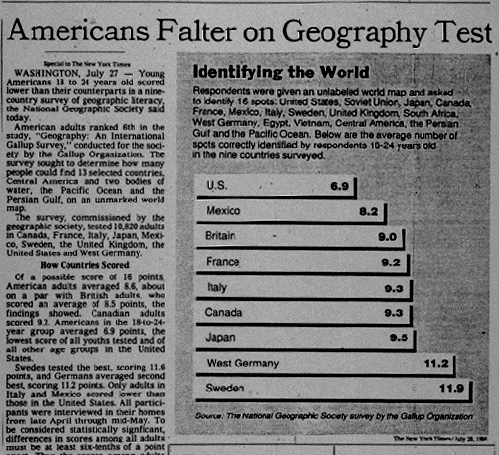
...to Geog 111 Main Page and Course Description
...to Geog 111 Syllabus
...to Geog 111 Course Schedule and Lecture Outlines
...to Geog 111 Course Project
Introduction to Earth's Physical Environment
1. Defining Geography
What geography studies: the earth
Geo-graphy: Greek words for "earth description"
Websters: "The descriptive science dealing with the surface of the earth, its divisions into continents and countries, and the climate, plants, animals, natural resources, inhabitants, and industries of the various divisions. The physical features, especially the surface features, of a region, area, or place."
Public perception of geography: where stuff is on the earth

Geographers interested in much more than just WHERE things are: geographers want
to know WHY things are WHERE the are
Three big categories of geographers
1) Human geographers
 World Languages: patterns of where and why
World Languages: patterns of where and why
2) Physical geographers: patterns of where and why
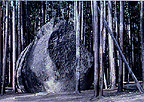
3) Environmental geographers: patterns where and why

All approach the world from a spatial perspective: how things vary from place to place: areal differentiation
This course will introduce you to two of the three major categories of geography
2. Introduction to Earth's Physical Environment
2a. The Solar System
Earth: one of the nine planets in our solar system
Earth's origins: the Big Bang
McKnight figure 1.5b: Elliptical Orbits
2b. Size and Shape of Earth
McKnight fig 1.6: Earth size: radius: 4000 miles
McKnight fig 1.7 earth shape
2c. The Geographic Grid
McKnight fig 1.8: Geographic Grid
Earth Coordinate Systems

McKnight fig 1.9: basis of Latitude/Longitude
McKnight fig 1.10: Great and Small Circles
Latitude: distance measured 90 degrees north and 90 degrees south of the equator
McKnight fig 1.11 measuring latitude
McKnight fig 1.12 parallels (latitude)
Longitude: distance measured 180 degrees east and 180 degrees west from an arbitrary meridian
McKnight fig 1.17: the geographic grid or graticule
2d. Earth Movements
Two basic Earth movements are vital
McKnight fig 1.18: Earth's Rotation on its Axis
McKnight fig 1.19: Earth's Revolution around the Sun
2f. Earth's Seasons
McKnight fig 1.20: Plane of the Ecliptic
Plane that passes through the Sun and through every point of Earth's orbit around the sun
The Earth's rotation axis is not perpendicular to the plane of the ecliptic
Different amounts of energy reaches the earth in different places

 Image from Animation
Image from Animation
McKnight fig 1.20: Plane of the Ecliptic
Combine rotation, revolution, inclination, and polarity: these differences in the
amount of solar energy reaching particular places on the earth - insolation -
changes over the year and leads to variations in climate we call seasons
The daily and seasonal variations in energy which hit a particular location on earth drive many important physical phenomena on the earth, and it is these physical phenomena which, over time, have played a large role in shaping the physical landscape of the Earth
3. Classifying the Natural World: Environmental Spheres, Ecosystems, and Biomes
3a. The Environmental Spheres
Biotic (living) and abiotic (non living) things and conditions:
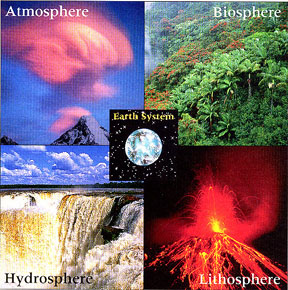
The Four Earthly Spheres
The four spheres are not discrete and separate, but intermingled
3b. Ecosystems and Biomes
Ecosystem: a group of environmental characteristics which define a particular area; the totality of interactions among organisms and the environment in the area of consideration;elements from all the earthly spheres
Many ways to classify ecosystems
Biomes: large areas of the earth can be categorized as relatively distinctive, with particular climate, animals, plants: a large, recognizable assemblage of plants and animals in functional interaction with its environment
Major World Biomes
McKnight fig 11.27: Major World Biomes
McKnight fig 11.27: Major World Biomes
4. Natural Cycles
Natural cycles are cycles of matter in the natural world: where molecules are formed and re-formed by chemical and biological reactions, manifested as physical changes in the matter
4a. The Hydrologic Cycle
McKnight fig 9.5: The Hydrologic Cycle
4b. The Carbon Cycle
McKnight fig 10.4: Carbon Cycle
Important: can't change one part of a system without having some effect on
another part of the same system, and other cycles and systems
One of the reasons we don't have a sense of the effects of our modification of
these natural systems is that they are often out of sync with our particular time
and location
5. Time and Space and Environmental Change
5a. Time and Environmental Change
Middleton table 1.2: Geologic Timescales and Important Events
Animation) Geologic Time Scale
Earth age: 4600 million years
Time scale chosen to study natural systems effects understanding
Dynamic equilibrium: input and output of matter in natural systems is balanced, but there are shorter term fluctuations
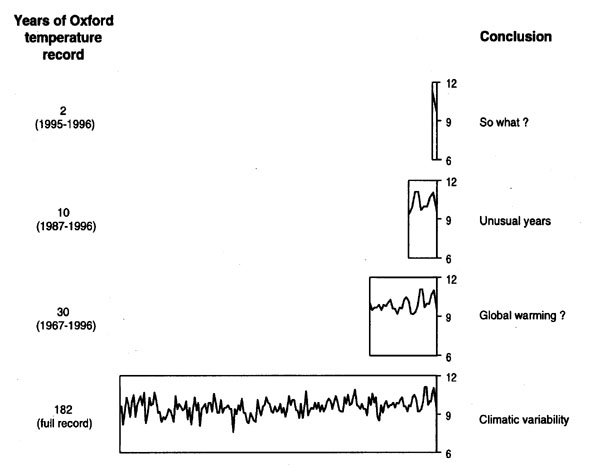
Feedback in a natural system
Thresholds: a change in a system may not occur until a threshold is reached
Change in natural the environment
5b. Spatial Scales and Environmental Change
Spatial scale also effects our understanding of environmental change
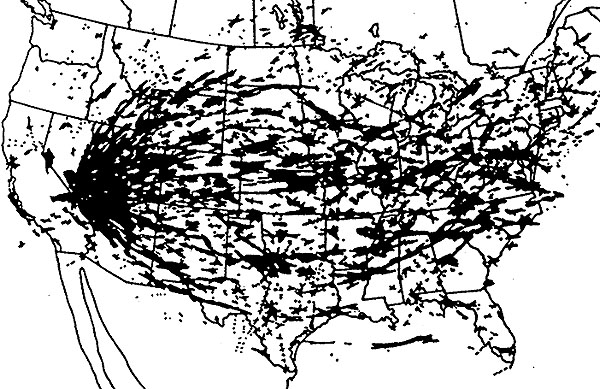
Role of thresholds and feedback: some areas more sensitive to change
Environmental issues we will discuss this semester have arisen as a consequence of
human activity in conflict with environmental systems
Conclusions: The State of our Knowledge
What we know about natural systems in the environment - how the environment works
Solid general understanding of natural systems
What is missing in many cases is an understanding of long term change in natural systems
What is also missing is a thorough understanding of the effects of human activity on
natural systems
These are the vital human issues: thus we have to link human systems to the natural systems and this is the realm of human-environmental geography and environmental studies
Next: an overview of Human Environmental Interactions
For next time:
E-mail: jbkrygier@owu.edu
...to Geog 111 Main Page and Course Description
...to krygier teaching page.
...to krygier top page.